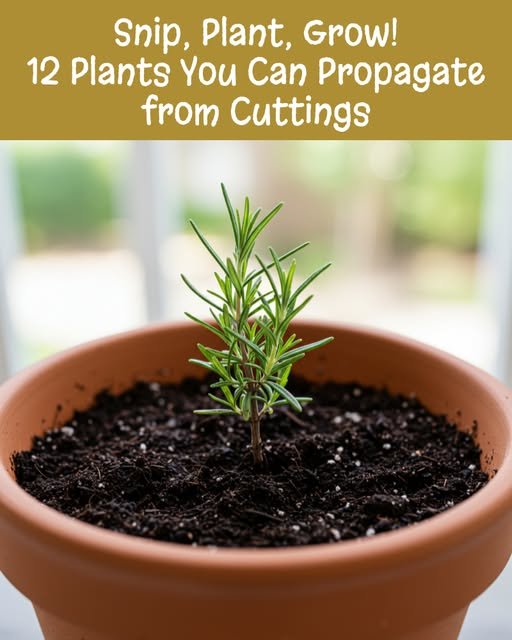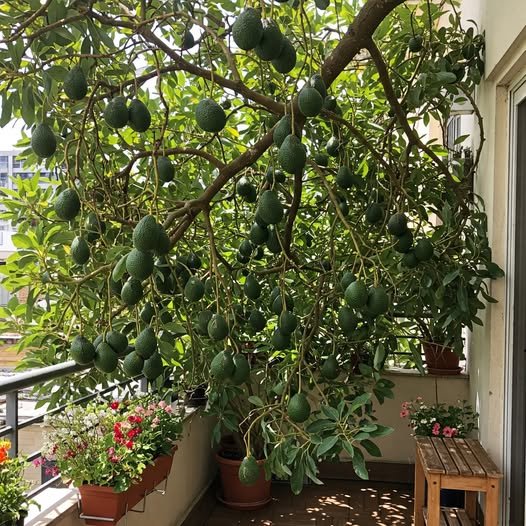Why spend a fortune on new plants when your garden is already full of free possibilities? Propagating plants from cuttings is one of the simplest, most satisfying ways to multiply your green babies—without touching a seed packet. Just a snip here, a little water or soil there, and voilà! New growth.
Whether you’re a beginner looking to dip your toes into gardening or a seasoned plant parent trying to stretch your plant budget, this method is foolproof. Let’s dive into 12 popular plants you can easily grow from cuttings—and exactly how to do it.
1. Rosemary
Best for: Indoor herb gardens, containers, and outdoor borders
Rosemary loves being propagated! Take a 4–6 inch softwood cutting (green and flexible, not woody), strip off the lower leaves, and pop it into water or well-draining soil. Keep it in a sunny spot, and roots should show up in 2–3 weeks.
Tip: Use rooting hormone for faster success.
2. Basil
Best for: Kitchen windowsills and herb pots
Clip a fresh, non-flowering basil stem right below a node (that’s where the leaf meets the stem). Place the cutting in a glass of water on a bright windowsill. You’ll see roots in about a week! Tip: Change the water every 2–3 days to prevent rot.
3. Pothos (Devil’s Ivy)
Best for: Hanging baskets and low-maintenance houseplant lovers
Pothos is nearly indestructible and roots like a champ. Snip a vine right below a node, remove the bottom leaves, and stick it in water. In just a few weeks, you’ll have roots long enough to pot.
Tip: Use a clear jar so you can monitor root growth.
4. Coleus
Best for: Colorful garden borders or indoor decor
This vibrant stunner roots quickly from soft stem cuttings. Take a 4–6 inch cutting, remove the bottom leaves, and place it in water or moist soil. Bright, indirect light is best.
Tip: Pinch back the tips for bushier growth.
5. Mint
Best for: Ground cover, teas, and natural pest repellent
Mint spreads fast, so it’s perfect for cuttings. Trim a 3–5 inch sprig and stick it in water or soil. You’ll have a root system forming in about a week or two.
Tip: Keep mint in pots unless you want it taking over your garden!
6. Snake Plant (Sansevieria)
Best for: Low-light indoor corners and air-purifying power
Cut a healthy leaf into 3–4 inch segments, and plant them cut-side down in moist soil or place them in water. Patience is key—roots can take several weeks to develop.
Tip: Label the top and bottom ends. Snake plants won’t root if planted upside down.
7. Hydrangea
Best for: Show-stopping summer blooms in shady gardens
Snip a non-flowering softwood cutting about 5–6 inches long. Remove the lower leaves, dip in rooting hormone, and plant in moist potting mix. Cover with a plastic bag to create a mini greenhouse.
Tip: Keep it out of direct sun until well-rooted.
8. Tomatoes
Best for: Garden beds, raised planters, and containers
Got a leggy tomato plant? Take a cutting from a healthy sucker or stem, remove the bottom leaves, and plant it directly into soil. Tomatoes root like magic! Tip: Water well and provide support as it grows.
9. Lavender
Best for: Fragrant borders, pollinator gardens, and dry spots
Take a 4–6 inch softwood cutting in spring or early summer. Strip off the bottom leaves and plant it in gritty soil or a sand-perlite mix. Keep the soil moist but not soggy.
Tip: Cover with a clear plastic dome to maintain humidity.
10. Geraniums (Pelargoniums)
Best for: Bright window boxes and flower beds
Clip a 4-inch stem cutting just below a node, remove lower leaves, and let the cutting sit out for a day to callous. Then plant it in well-draining soil. Roots form quickly in warm weather.
Tip: Water sparingly at first—too much moisture leads to rot.
11. Sweet Potato Vine (Ornamental)
Best for: Fast-growing groundcover or dramatic hanging baskets
Cut a vine about 6 inches long, strip the bottom leaves, and pop it in water. You’ll see long white roots within days. Plant once they’re a few inches long.
Tip: This method also works with edible sweet potatoes grown in water.
12. Begonia
Best for: Shady porches and colorful indoor accents
Some begonias root from leaf cuttings, while others do best with stem cuttings. Take a healthy piece, stick it in soil or water, and keep the humidity high until roots appear.
Tip: Cover with a humidity dome or place the pot in a clear plastic bag.
FAQs About Propagating Plants from Cuttings
How long do cuttings take to root?
It depends on the plant. Herbs like basil and mint can root in a week, while woody or thick-stemmed plants like snake plant may take several weeks.
Should I use water or soil to root cuttings?
Both work! Water is great for visibility and quick rooting, while soil can help avoid transplant shock. Some plants prefer one over the other.
What’s the best time of year to take cuttings?
Spring and early summer are ideal, especially for softwood cuttings. Avoid propagating during a plant’s dormant season (usually winter).
Final Thoughts
Propagating from cuttings is like garden magic—snip a stem, give it some TLC, and you’ve got a whole new plant! Whether you’re multiplying your favorites, swapping with friends, or just feeding your plant obsession, this method is an easy win.
So grab those scissors, choose a plant, and get snipping. Your garden (and your wallet) will thank you.



